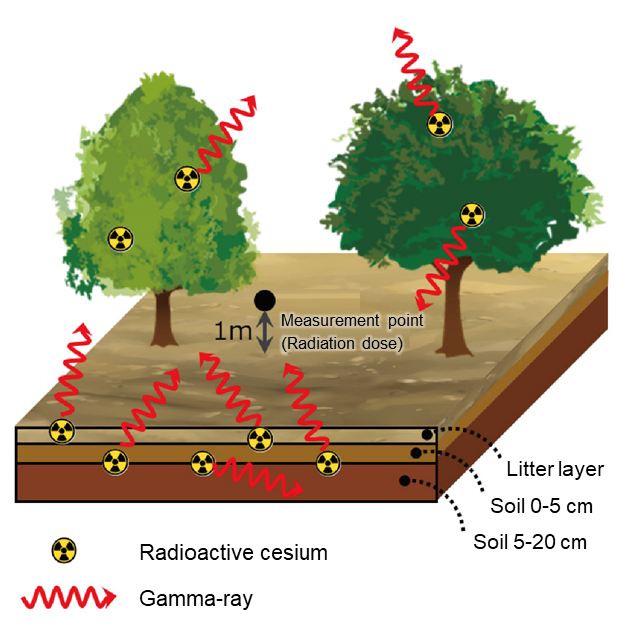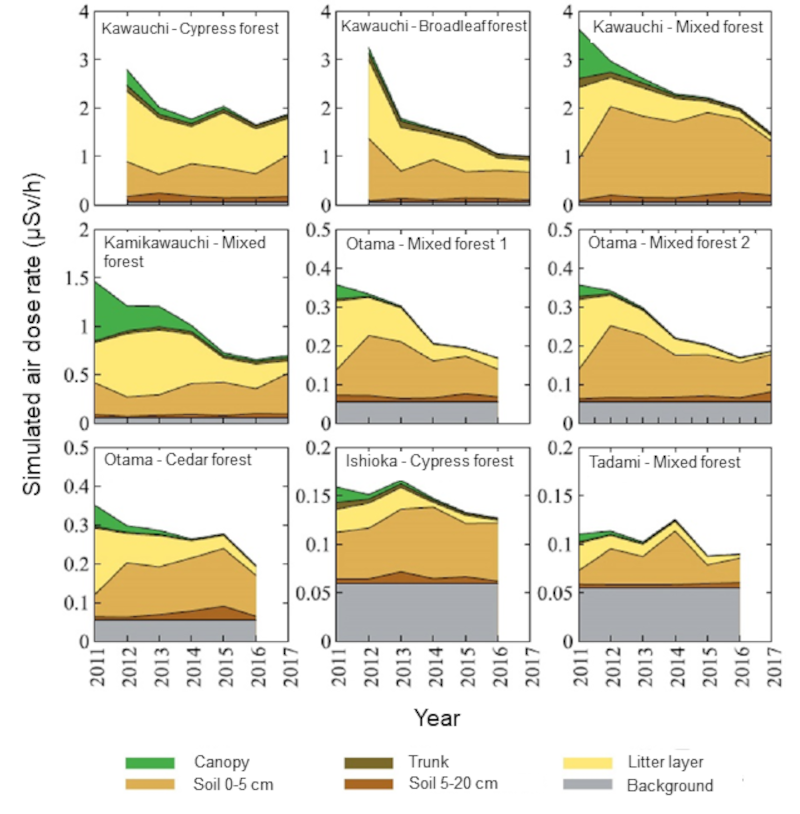Radioactivity Dynamics in forests
(2021)
QWhat is the relationship between the movement of cesium in forests and air dose rates?
AIn collaboration with the Forestry and Forest Products Research Institute (FFPRI) and the University of Tsukuba (UT), JAEA has built a detailed model of radioactive cesium distribution in forests based on the results of measurement by FFPRI and UT and performed radiation simulation.
As a result, it was found that a large majority of radiation doses in forests has come from radioactive cesium that is present in the top soil layer of 0-5 cm since 2017. This result indicates that behavior of radioactive cesium determines future changes in the radiation doses.

Fig. 1 Schematic illustration of how gamma-rays generated from radioactive 134Cs and 137Cs atoms present in a forest contributes to the radiation dose (observation point) in the forest
Since March 2011, researchers from the Forestry and Forest Products Research Institute (FFPRI), University of Tsukuba (UT), and JAEA have diligently surveyed forests near the Fukushima Daiichi NPS and have accumulated exhaustive and abundant radiation data. For this report, the institutions collaborated to build a forest simulation model using the data. Using the model built, by inputting the distribution of radioactive cesium in the tree canopy, trunk, litter layer, and soil layers in a forest as well as their material densities, it has become possible to calculate the amount of gamma-rays released from radioactive cesium, i.e. radiation doses, for any point in the forest (Fig. 1).
For the simulation of gamma-rays, the Particle and Heavy Ion Transport code System (PHITS), a radiation behavior analysis code developed by JAEA, was used to simulate the pathway of gamma-rays released from the decay of radioactive 134Cs and 137Cs and their scattering by interaction with materials. In the simulation, calculating the effects of radioactive cesium present in various parts of the forest on the radiation dose in the forest allows us to derive the percent contribution of each part.

Fig. 2 Temporal change in the contribution of the tree canopy, trunk, litter layer, soil 0-5 cm layer, soil 5-20 cm layer, and background to the radiation doses (air dose rates (μSv/h)) in nine forests in Eastern Japan (Ishioka is in Ibaraki, the rest are in Fukushima)
A mixed forest is a forest consisting of two or more types of trees (a mixed forest of broadleaf trees and coniferous trees). Note that, measurement and simulation data include small errors.
Fig. 2 shows some examples of simulation results. As can be seen in Fig. 2, the radiation doses have been reducing with time, and the contribution ratio of each layer of the forests has been greatly changing (the charts show results for a maximum of six years from the accident at the Fukushima Daiichi NPS that occurred in 2011).
Detailed investigation of Fig. 2 tells us that radioactive cesium in the tree canopy and trunk was one of the main factors of radiation doses in 2011 (the year the accident occurred). However, radioactive cesium moved to the forest floor after that, and the effect of radioactive cesium in the tree canopy and trunk rapidly dropped over several years after the accident. Radioactive cesium in the litter layer greatly affected the radiation doses from 2012 to 2015, but by 2017 (by 2016 for some), radioactive cesium has moved from the litter layer to the soil layer and the top soil layer of 0-5 cm has become the most important factor of radiation doses in the forests. These results indicate that future changes in radiation doses in forests will be dictated by the movement of radioactive cesium in the top soil layer of 0-5 cm.
These results also suggest what kind of forest management is effective in controlling radiation doses in forests. For example, it is possible to calculate how air dose rates would change if decontamination to remove the litter layer that covers the forest soil is performed or if a certain thickness of wood chip layer is laid. It will also be possible to predict changes in radiation doses if the litter layer keeps getting gradually renewed as a result of leaves and branches continuously falling onto it.
This study discovered that, since 2017, radioactive cesium in the top soil layer of 0-5 cm has been the most important factor of radiation doses in forests affected by the NPS accident that occurred in 2011. The model developed in this study enables not only detailed comparative analysis of various hypotheses but also evaluation of impacts of forest management to be implemented in the future. For example, while measures such as thinning, clear-cutting, and removal of litter layer change the location and amount of radioactive cesium distributed in a forest, they also change their effect of shielding gamma-rays emitted from radioactive cesium. These effects are mutually contradictory, and cannot be expressed in a simple relationship. Therefore, when implementing measures like those above, a simulation is required to clearly estimate how radiation dose may change. We plan to further promote R&D utilizing the characteristics of such simulations for the purpose of making realistic proposals toward effective reduction of radiation doses in forests in the future.
Related articles
- I heard most of the forests would not be decontaminated. Does cesium remain in the forests?
- How does radioactive cesium in forests move from trees to the ground surface? 【Movement in throughfall, stemflow, and litterfall】
- How does radioactive cesium in forests move from trees to the ground surface? 【Movement as particulate and dissolved states】
